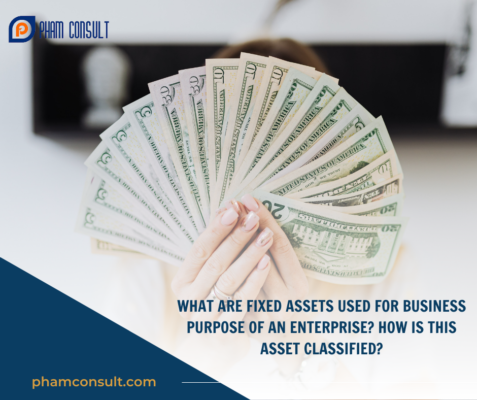Fixed assets in businesses are also divided into many types such as tangible fixed assets, intangible fixed assets or financial leased fixed assets. In today’s article, join Pham Consult to find out what fixed assets are? And properly understand intangible fixed assets and tangible fixed assets according to regulations.

What are fixed assets used for business purposes? How is this asset classified?
According to the provisions of Article 6 of Circular 45/2013/TT-BTC (amended by Clause 2, Article 1 of Circular 147/2016/TT-BTC), fixed assets used for business purposes are fixed assets. managed by the enterprise and used for its business purposes.
Fixed assets used for business purposes are classified as follows:
(1) For tangible fixed assets, enterprises classify as follows:
Type 1: Buildings and architectural objects: are fixed assets of the enterprise formed after the construction process such as headquarters, warehouses, fences, water towers, yards, and decorative works. decoration for houses, roads, bridges, railways, airport runways, piers, wharves, and slopes.
Type 2: Machinery and equipment: are all types of machinery and equipment used in the business activities of the enterprise such as specialized machinery, working equipment, drilling rigs in the oil and gas sector, cranes, technological lines, single machines.
Type 3: Means of transport, transmission equipment: means of transport including means of transport by rail, waterway, road, air, pipelines and transmission equipment such as information systems , electrical systems, water pipes, conveyors, air pipes.
Type 4: Management equipment and tools: are equipment and tools used in managing business activities of the enterprise such as computers for management, electronic equipment, equipment and tools measurement, quality control, dehumidifiers, vacuum cleaners, termite protection.
Type 5: Perennial gardens, working animals and/or products: are perennial gardens such as coffee gardens, tea gardens, rubber gardens, fruit gardens, lawns, green carpets, etc. .; Animals that work and/or produce products such as elephants, horses, buffaloes, cows…
Type 6: Fixed assets are infrastructure, of great value, invested and built by the State from the state budget and assigned to economic organizations to manage, exploit and use:
– Fixed assets are machinery and equipment, production lines, assets built from concrete and soil of works directly serving irrigation and drainage (such as lakes, dams, canals, ditches). ; Water pumps of 8,000 m3/hour or more along with architectural objects used to operate projects are assigned to single-member limited liability companies with 100% charter capital owned by the State to manage. exploit irrigation works to organize production and business to provide public services;
– Fixed assets are structural works and industrial park infrastructure invested by the State for common use of the industrial park such as: Internal roads, lawns, trees, lighting systems, drainage systems and wastewater treatment…;
– Fixed assets are railway and urban railway infrastructure (tunnels, elevated structures, tracks…).
Type 7: Other types of fixed assets: are all other fixed assets not listed in the six types above.
(2) Intangible fixed assets: land use rights, publishing rights, invention patents, literary, artistic, scientific works, products, results of artistic performances, records audio, video recording, broadcasting, encrypted program-carrying satellite signals, industrial designs, semiconductor integrated circuit layout designs, trade secrets, trademarks, trade names and designations geography, plant varieties and propagating materials.
Can businesses classify fixed assets for business purposes?
Pursuant to Article 6 of Circular 45/2013/TT-BTC regulating the classification of fixed assets of enterprises as follows:
Classification of fixed assets of the enterprise:
…
3. Fixed assets preserved on behalf of, kept on behalf of, or stored on behalf of are fixed assets that enterprises preserve on behalf of, keep on behalf of other units, or store on behalf of the State according to regulations of competent State agencies. permission.
4. Depending on the management requirements of each enterprise, enterprises classify their fixed assets in more detail into each group accordingly.
Thus, according to regulations, businesses can classify fixed assets used for business purposes in more detail as appropriate.
Where are the costs businesses spend to invest in upgrading fixed assets reflected?
Costs that businesses spend to invest in upgrading fixed assets are specified in Article 7 of Circular 45/2013/TT-BTC
Investing in upgrading and repairing fixed assets:
1. The costs an enterprise spends to invest in upgrading fixed assets are reflected in an increase in the original price of that fixed asset. These costs must not be accounted for in production and business expenses during the period.
2. Fixed asset repair costs are not calculated to increase the original price of fixed assets but are directly accounted for or gradually allocated to business expenses during the period, but not exceeding 3 years.
…
Accordingly, the costs businesses spend to invest in upgrading fixed assets are reflected in an increase in the original price of that fixed asset and these costs are not accounted for in production and business expenses in the period.
Costs that businesses spend to invest in upgrading fixed assets are specified in Article 7 of Circular 45/2013/TT-BTC
Investing in upgrading and repairing fixed assets:
1. The costs an enterprise spends to invest in upgrading fixed assets are reflected in an increase in the original price of that fixed asset. These costs must not be accounted for in production and business expenses during the period.
2. Fixed asset repair costs are not calculated to increase the original price of fixed assets but are directly accounted for or gradually allocated to business expenses during the period, but not exceeding 3 years.
…
Accordingly, the costs businesses spend to invest in upgrading fixed assets are reflected in an increase in the original price of that fixed asset and these costs are not accounted for in production and business expenses in the period.
Comments




 VI
VI